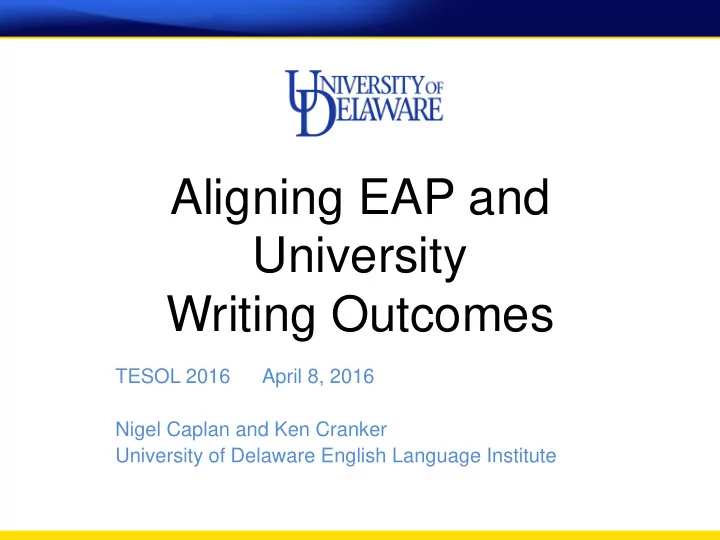

Aligning EAP and University Writing Outcomes TESOL 2016 April 8, 2016 Nigel Caplan and Ken Cranker University of Delaware English Language Institute
Context 5 4.5 4 723 u’grads 3.5 3 2.5 2 153 u’grads 1.5 1 0.5 0 2007 2008 2009 2010 2011 2012 2013
A pathways model
EAP Pathways Intensive English Program Initial placement in Basic, I, II, III, IV, or V RW and LS classes Level VI Academic Preparation (if needed) EAP I (Foundations) 4 months for most students Core class (integrated skills); 6 credits on matriculation* Language/culture electives Academic engagement and study skill classes Additional language support as needed EAP II (Transitions) 1 UD semester, including: EAP II/E110 (FYC) for Multilingual Students (3 credits) UD Bridge Course(s) with ELI support (up to 6 credits) Academic engagement and study skill classes Additional language support as needed Full UD Matriculation
Aligning Writing Learning Outcomes • Needs analysis • Bridging IEP to FYC outcomes • Starting with the end in mind • Source-based writing • Pathways not gatekeepers 4
Needs Analysis Revelations • Range of assigned writing • Disciplinary differences • Shorter forms of writing Caplan & Stevens (under review) 5
Starting with End in Mind • Learning outcomes of new Pathways model developed first • Exit criteria for IEP • Exit criteria for EAP 6
Exit Criteria for IEP • strong general vocabulary • developing academic vocabulary • general interest reading • can infer, conclude, and summarize • focused and organized writing • mostly solid grammar 7
Exit Criteria for EAP • E110 (first-year composition) Learning Outcomes • Existing EAP Learning Outcomes 8
E110 (FYC) Learning Outcomes • Critical Reading • Writing Process • Rhetorical Knowledge • Knowledge of Conventions 9
EAP Writing Outcomes • Sources: Journalism, student writing, academic texts • Appropriate academic level of vocabulary • Reflecting clear thinking (analysis, opinions, conclusions) 10
• Source selection, use and citation • Process of writing • Variety of university genres (summary, response, argument) • Range of tasks (short answer, email, multi-draft reports) 11
• Summarizing and synthesizing • Reflecting unity and clarity (focused, cohesive, coherent) • Illustrating grammatical sophistication (diverse sentence types, proper tenses and usage) • Understanding format (APA, MLA) 12
Writing Based on Reading • Source-based writing activities – comprehension questions – summaries – responses – syntheses – research (especially in EAPII) 13
Providing Pathways • End “gate - keeper mentality” • Equip, educate, and merge o Support for Writing Program faculty o EAP II/E110-NNS 14
Implementation • Piloting EAPI now with special sponsored group • Tweak • Introduce in Fall 15
Recommend
More recommend